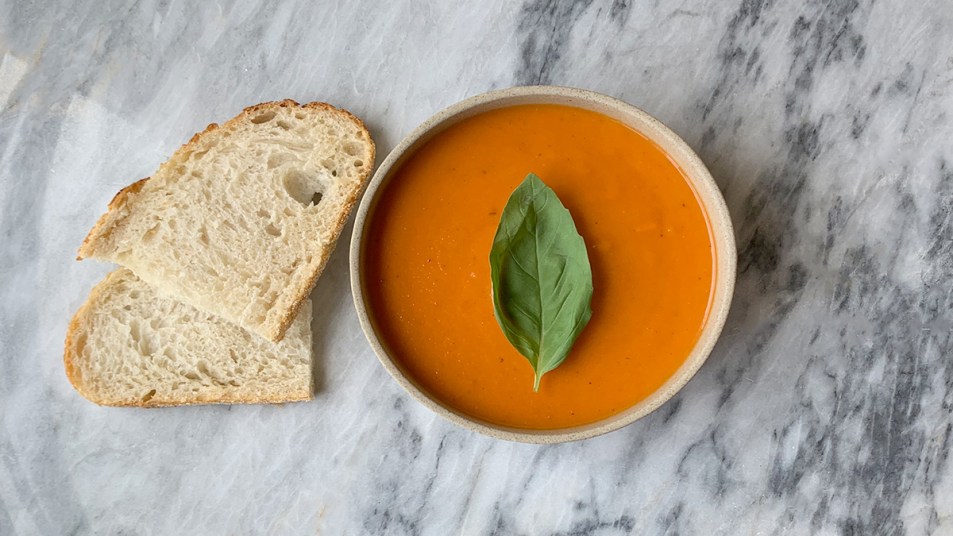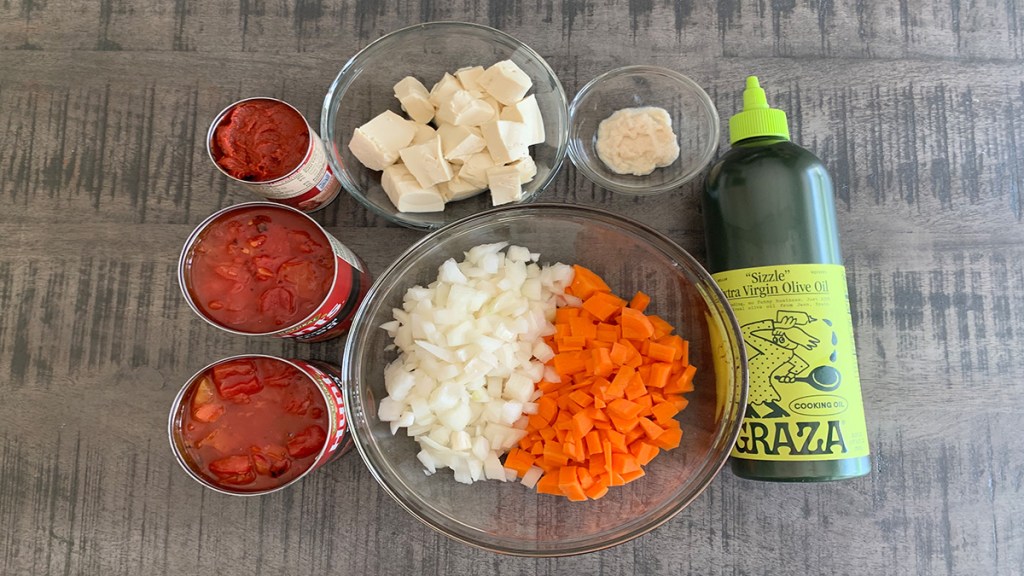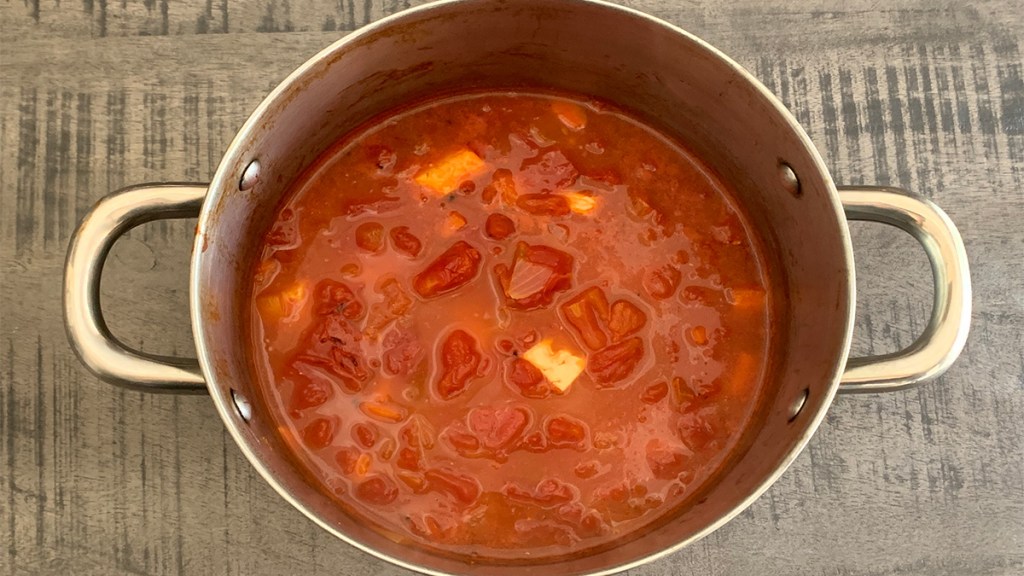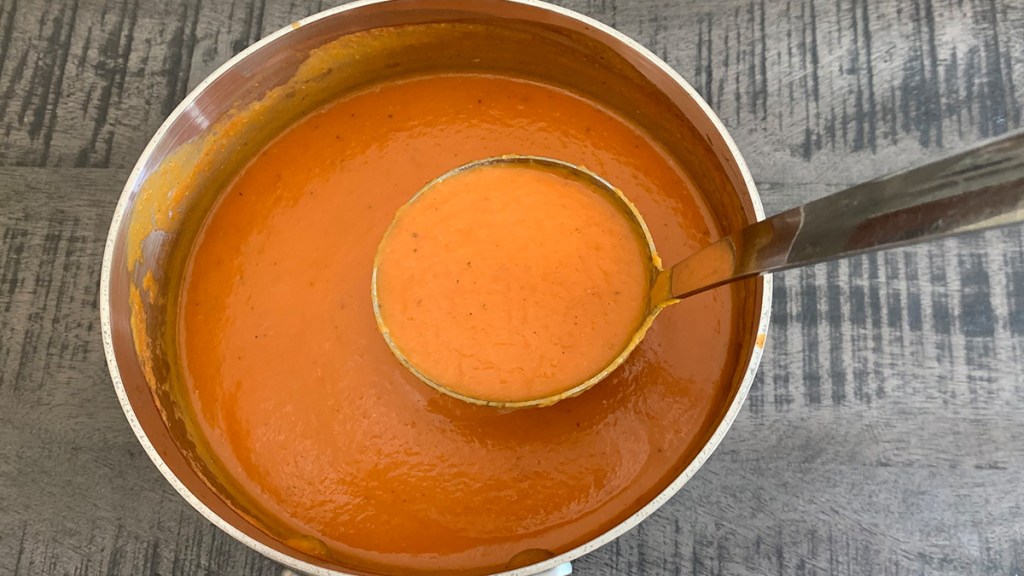For Tastier (and Healthier) Tomato Soup, Use Tofu Instead of Heavy Cream — Here’s How
You won't even notice that this plant-based protein is in the soup.

As a kid, I couldn’t watch 10 minutes of television without seeing a Campbell’s tomato soup commercial. I remember the bowls of bright red tomato soup lighting up my screen while the ad’s catchy jingle played. But while that commercial fueled my love of tomato soup and grilled cheese, these days I ditch the canned soup and go homemade. This allows me to control the ingredients, so my soup is both delicious and nutritious. One typical tomato soup ingredient I try to avoid is heavy cream; it might create a silky-textured soup, but it’s also laden with extra calories and fat. The fix I’ve discovered? Swapping heavy cream for tofu. It still produces a smooth and thick tomato soup, but with far fewer calories. Keep reading for a tasty tomato soup recipe that uses the plant-based protein to put a healthy spin on an old classic.
The Unhealthy Truth About Tomato Soup
Tomato soup’s creamy texture — whether homemade or store-bought — can usually be credited to heavy cream. This fat-rich cream creates the soup’s thick consistency, but it’s high in calories. One tablespoon of heavy cream contains about 51 calories, so even the smallest amount can add up. This is especially true for a commercial soup like Campbell’s Creamy Tomato Soup, which contains 200 calories in each serving-sized container.
While it’s fine to consume heavy cream in moderation, finding a healthier substitute for your soup will allow you to enjoy more of it without guilt. Tofu is often used in savory dishes as a meatless protein — however, it also produces a lighter version of tomato soup. How? Two ounces (or ¼ cup) of firm tofu contains approximately 82 calories, and it forms a thick consistency once cooked and blended. Plus, tofu’s bland flavor means you’ll barely notice it’s there after puréeing the soup! (Click through to our silken tofu story to learn more about this ingredient’s health benefits and versatility.)
How To Make Healthier Tomato Soup
Nutrition expert Joy Bauer, MS, RDN, CDN, shares a creamy tomato soup recipe on her website that clocks in at 70 calories per one cup serving. For this recipe, you can use any type of tofu (firm, silken, or extra-firm) — just drain it beforehand to avoid a watery soup. Additionally, use an olive oil like Gaza’s “Sizzle”Extra Virgin Olive Oil (Buy from Graza.co, $15) to sauté the vegetables; it boasts a mellow flavor and a high smoke point.
Ingredients:
- 1 tablespoon extra virgin olive oil
- 1 medium onion, diced
- 2 medium carrots, peeled and chopped
- 2 cloves garlic, minced
- 3 tablespoons no-salt-added tomato paste
- 28 ounces canned diced fire-roasted tomatoes
- 8 ounces tofu (silken, firm, or extra-firm), drained and cut into large cubes
- Salt and ground black pepper, to taste
Directions:
- Prep: 10 mins
- Total Time: 1 hour
- Yield: 8 cups
- Heat olive oil in large pot or Dutch oven over medium heat.
- Add onion, carrots, and garlic and sauté until vegetables are tender, about 8 minutes. Add tomato paste and cook, stirring constantly, for one minute.
- Add canned tomatoes. Fill empty tomato can with water and pour water into pot.
- Bring soup to boil, cover the pot, reduce heat to low, and simmer for 15 minutes. Stir in tofu and simmer, uncovered, for 15 more minutes.
- Puree soup in small batches in blender until completely smooth. (Alternatively, use immersion blender to puree soup directly in pot.) Season with salt and black pepper.



My Taste Test
If I did a blind taste test of this tomato soup against a cream-filled one, I wouldn’t be able to tell the difference. This tofu-tomato soup has the hearty, sweet, and acidic flavors of the traditional version, with the reddish orange color to boot. The tofu didn’t contribute to the soup’s taste, but it did provide it with a creaminess that wasn’t overly rich or indulgent. Because of this, I enjoyed two servings and didn’t feel too full afterward. (Considering this recipe yields 8 cups, a second helping is warranted — unless you’re feeding a crowd.)
My only modification to this recipe was using premade garlic paste instead of freshly minced garlic. This prevented me from having to chop another ingredient, while still infusing the soup with a pleasantly pungent flavor.
Overall, this recipe proves that the most unlikely ingredients can create the most satisfying results. This dreamy soup was delicious as is — but next time, I’ll stir in some thinly sliced basil leaves to give it slight notes of anise. Although soup season officially starts in the fall, there’s plenty of times when I’m craving a bowl of childhood comfort in spring!
















